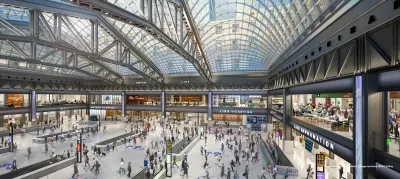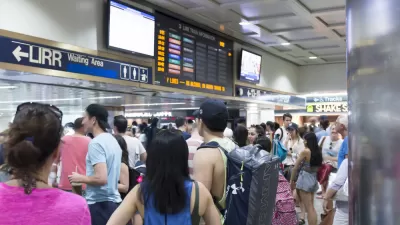Some of the time and money invested in the visually spectacular Moynihan Station should have been spent looking at how well it actually works for commuters, writes Alon Levy.

At CityLab, Alon Levy writes that while New York City’s new Moynihan Station will be a vast aesthetic improvement on the old Penn Station, “[m]ost of the project’s budget prioritizes the station’s form while not addressing the problems with its function.”
Penn Station is arguably the least likeable major transit station in the world, and less arguably the most hated transit station in New York City. In the 1960s a majestic Beaux Arts building was torn down and replaced with a warren of uninspiring and confusing tunnels unceremoniously topped with Madison Square Garden.
Much has been written about the demise of the first Penn Station and the faults of the second; the late Senator Daniel Patrick Moynihan, for whom the third Penn Station will be named, began working on the idea of co-opting the adjacent Farley Post Office—another Beaux Arts building—in the early 1990s.
The first phase of the new station opened last summer to widespread enthusiasm, and construction on the second began soon after.
The problem, according to Levy, is that delight over creating a beautiful space has meant that the more basic tenets of good transportation design have been sidelined.
“A station’s form should follow this function. The grandeur of old stations often responded to the functional needs of the steam era and was not just artistic: For example, soaring waiting rooms separate from the station tracks made sense when steam locomotives were belching smoke. In the modern era, the concerns are different.”
In the modern era, more than half a million people pass through Penn Station every day via three major regional transportation entities—the Long Island Rail Road, New Jersey Transit and Amtrak—in addition to numerous lines of the New York City Subway.
“A train station’s primary function,” Levy writes, “certainly in New York, is to get passengers between the train and the subway as fast as possible.”
No one has ever argued that Penn Station does a terrific job, but Levy thinks Moynihan doesn't do any better,
“Penn Station’s worst design problem above the track level is that each of the station’s three users—Amtrak, the LIRR, and NJT—treats its part of the station as its own fief. The LIRR has the lower concourse, where ticket machines sell only LIRR tickets and the information screens show no information about Amtrak or NJT trains. Amtrak and NJT use the upper concourse, each with its own ticket offices and information screens.”
“Moynihan Station,” Levy writes, “makes this problem worse by moving Amtrak and LIRR to a completely separate headhouse, even farther from NJT.”
Levy suggests that integrated ticketing and information screens, an extended LIRR concourse and—perhaps the most basic improvement over the current Penn Station—timeliness, would make a significant, if less spectacular, difference to travelers.
“None of these investments would create a monumental train hall like Phase 2 of Moynihan Station, but they’d have tangible benefits. If form follows function, then these, and not a new building, should have the most positive effect for users of Penn Station.”
FULL STORY: Why a New Train Hall Won't Fix Penn Station

Alabama: Trump Terminates Settlements for Black Communities Harmed By Raw Sewage
Trump deemed the landmark civil rights agreement “illegal DEI and environmental justice policy.”

Planetizen Federal Action Tracker
A weekly monitor of how Trump’s orders and actions are impacting planners and planning in America.

The 120 Year Old Tiny Home Villages That Sheltered San Francisco’s Earthquake Refugees
More than a century ago, San Francisco mobilized to house thousands of residents displaced by the 1906 earthquake. Could their strategy offer a model for the present?

Ken Jennings Launches Transit Web Series
The Jeopardy champ wants you to ride public transit.

BLM To Rescind Public Lands Rule
The change will downgrade conservation, once again putting federal land at risk for mining and other extractive uses.

Indy Neighborhood Group Builds Temporary Multi-Use Path
Community members, aided in part by funding from the city, repurposed a vehicle lane to create a protected bike and pedestrian path for the summer season.
Urban Design for Planners 1: Software Tools
This six-course series explores essential urban design concepts using open source software and equips planners with the tools they need to participate fully in the urban design process.
Planning for Universal Design
Learn the tools for implementing Universal Design in planning regulations.
Clanton & Associates, Inc.
Jessamine County Fiscal Court
Institute for Housing and Urban Development Studies (IHS)
City of Grandview
Harvard GSD Executive Education
Toledo-Lucas County Plan Commissions
Salt Lake City
NYU Wagner Graduate School of Public Service




























